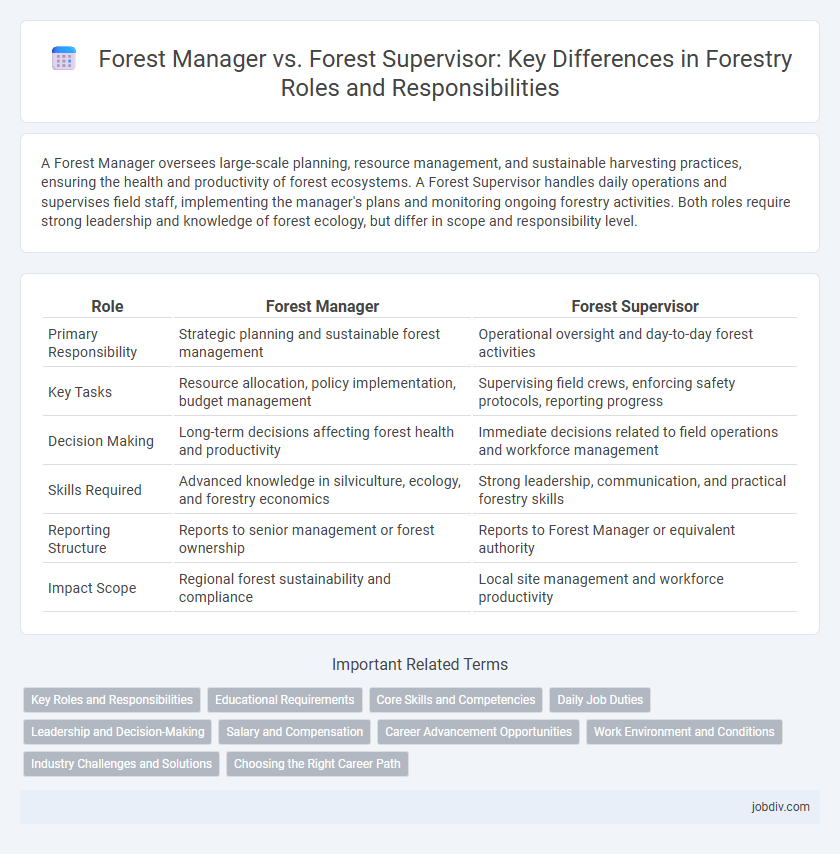A Forest Manager oversees large-scale planning, resource management, and sustainable harvesting practices, ensuring the health and productivity of forest ecosystems. A Forest Supervisor handles daily operations and supervises field staff, implementing the manager's plans and monitoring ongoing forestry activities. Both roles require strong leadership and knowledge of forest ecology, but differ in scope and responsibility level.
Table of Comparison
| Role | Forest Manager | Forest Supervisor |
|---|---|---|
| Primary Responsibility | Strategic planning and sustainable forest management | Operational oversight and day-to-day forest activities |
| Key Tasks | Resource allocation, policy implementation, budget management | Supervising field crews, enforcing safety protocols, reporting progress |
| Decision Making | Long-term decisions affecting forest health and productivity | Immediate decisions related to field operations and workforce management |
| Skills Required | Advanced knowledge in silviculture, ecology, and forestry economics | Strong leadership, communication, and practical forestry skills |
| Reporting Structure | Reports to senior management or forest ownership | Reports to Forest Manager or equivalent authority |
| Impact Scope | Regional forest sustainability and compliance | Local site management and workforce productivity |
Key Roles and Responsibilities
Forest managers develop comprehensive forest management plans, oversee sustainable timber harvesting, and coordinate reforestation efforts to ensure long-term forest health and productivity. Forest supervisors implement these plans by managing daily operations, supervising field staff, and monitoring compliance with environmental regulations and safety standards. Both roles require expertise in forest ecology, resource management, and regulatory frameworks but differ in scope, with managers focusing on strategic planning and supervisors handling operational execution.
Educational Requirements
Forest Managers typically require a bachelor's degree in forestry, environmental science, or natural resource management to develop strategic plans and oversee large-scale forest operations. Forest Supervisors often hold an associate degree or forestry technician certification, emphasizing practical skills for on-site supervision and enforcement of forest policies. Advanced degrees or specialized training in forest ecology or management can enhance career prospects in both roles.
Core Skills and Competencies
Forest Managers excel in strategic planning, resource allocation, and sustainable forest management practices, ensuring long-term ecosystem health and economic viability. Forest Supervisors focus on operational oversight, crew coordination, and field-level implementation of forestry plans, emphasizing safety and compliance with environmental regulations. Both roles require strong communication, problem-solving skills, and knowledge of forestry technology, but managers prioritize high-level decision-making while supervisors concentrate on tactical execution.
Daily Job Duties
Forest managers develop strategic plans for sustainable forest use, oversee harvesting operations, and ensure compliance with environmental regulations, focusing on long-term forest health and productivity. Forest supervisors coordinate daily field activities, manage work crews, monitor equipment usage, and implement safety protocols to maintain efficient timber harvesting and site maintenance. Both roles emphasize sustainable forestry practices, but managers prioritize planning and regulatory adherence while supervisors handle direct operational execution.
Leadership and Decision-Making
Forest Managers exhibit strategic leadership by developing long-term management plans that balance ecological sustainability with economic goals, whereas Forest Supervisors focus on operational leadership by overseeing daily activities and ensuring adherence to management plans. Decision-making for Forest Managers involves evaluating complex environmental data and policy implications to set priorities, while Forest Supervisors make tactical decisions related to workforce coordination and on-site problem-solving. Both roles require strong communication skills, but managers emphasize visionary leadership, and supervisors prioritize direct team guidance.
Salary and Compensation
Forest Managers typically earn higher salaries than Forest Supervisors, with average annual compensation ranging from $65,000 to $90,000 compared to $45,000 to $65,000 for supervisors. Managers often receive additional benefits such as performance bonuses, profit-sharing, and comprehensive health insurance due to their higher level of responsibility and decision-making authority. Supervisors may have more modest benefits packages but gain valuable experience that can lead to higher-paying managerial roles in forestry.
Career Advancement Opportunities
Forest Managers typically have broader leadership responsibilities and strategic planning roles compared to Forest Supervisors, positioning them for higher-level career advancement in forestry organizations. Forest Supervisors often gain hands-on experience with operational management, which can serve as a stepping stone to managerial positions. Advancing from Forest Supervisor to Forest Manager usually requires enhanced expertise in resource management, budgeting, and regulatory compliance.
Work Environment and Conditions
Forest Managers typically work in diverse environments, balancing office-based planning with periodic field inspections in remote woodland areas, facing variable weather and terrain challenges. Forest Supervisors primarily operate on-site, overseeing daily forestry operations under outdoor conditions, often requiring physical endurance and adaptability to seasonal changes. Both roles demand rigorous safety adherence due to potential hazards like heavy machinery, wildlife encounters, and unpredictable environmental factors.
Industry Challenges and Solutions
Forest Managers address industry challenges such as sustainable resource allocation, climate change impact, and regulatory compliance by implementing strategic planning and advanced modeling tools. Forest Supervisors focus on on-the-ground issues like workforce coordination, operational safety, and real-time problem-solving to ensure efficient timber harvest and land restoration practices. Both roles collaborate to optimize forest health, biodiversity conservation, and economic viability amidst increasing environmental and regulatory pressures.
Choosing the Right Career Path
Forest Managers oversee large-scale forest planning, resource management, and regulatory compliance, requiring advanced expertise in ecology and business administration. Forest Supervisors focus on on-the-ground operations, coordinating crews, enforcing safety protocols, and maintaining forest health through tactical decision-making. Selecting the right career path depends on one's preference for strategic planning and stakeholder engagement versus hands-on supervision and fieldwork experience.
Forest Manager vs Forest Supervisor Infographic

 jobdiv.com
jobdiv.com